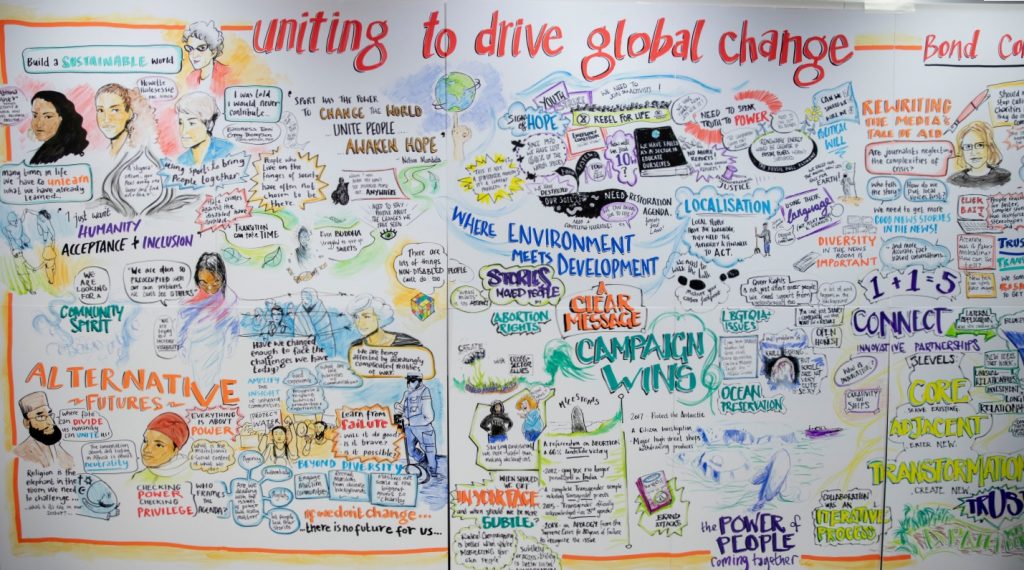Why the current development system prevents Southern NGOs from thriving – Barbara Nöst’s remarks from the BOND conference
29 May 2019

“Visual minutes” from the BOND conference, which brings together more than 1,000 actors from the international development and humanitarian sectors
The following are the remarks made by Barbara Nöst, Chief Executive Officer of the Zambian Governance Foundation (ZGF), during a plenary session at the March 2019 BOND conference in London. A video recording of Barbara’s remarks is also available.
“I assume that you will be puzzled by a European representing a Zambian NGO. I think I represent a real dilemma, and I would like to offer some of my thoughts how we can maybe try to resolve this dilemma collectively as civil society in the international development sector. The dilemma I refer to is how the current aid system and civil society financing is structured. The current system makes it impossible for local Southern NGOs to grow and thrive.
1. While we at Zambia Governance Foundation understand the various constraints donor agencies face when deciding on the best way to transfer aid money to end beneficiaries, we believe there are too many intermediaries that benefit from this architecture. These are international consultancy firms, foreign academic institutions, global vertical funds, UN agencies, donor funded pools, international NGOs and intergovernmental institutions. These entities have to collaborate with local counterparts as they are not familiar with the local context, such as international NGOs or their local branches, local academic institutions, local consulting firms and local well-established NGOs. Each intermediary absorbs a share of the budget to cover its own administrative fees before the funds arrive at the lowest level of the hierarchy, the local NGO. As we can see from reports, such as the 2018 Global Humanitarian Assistance reporting, funding received by local NGOs is pitifully small (0.3%).
2. Compliance principles, log-frames, objectives, indicators, sources of verification and results largely serve the donor, absorb much of the time and energy of an NGO, but do little to change the lives of those we serve.
3. At the Zambia Governance Foundation, we have administered seven calls for proposals, a methodology widely used and one which is justified with the argument that these calls help widen access to civil society financing. More than 1,000 applications have gone through our system over the past nine years, but we have come to the conclusion that competitive calls for proposals are of limited value:
- First of all, they create unnecessary competitiveness. Even the most in-depth assessment process might not be enough to identify an NGO which is managed by people that are truly motivated to make a difference.
- The smartest, well-established NGOs will always be on top of the short-list, while emerging local NGOs fall through the cracks.
- A strong proposal does not necessarily mean that an organization is able to implement a project as indicated on paper. Well-resourced NGOs hire fundraising consultants who write brilliant proposals.
- The situation gets even worse when these calls are open to both international and local NGOs. This opens the doors for international NGOs who fly into the country in search for local partners and then close their offices as soon as the project comes to an end. This approach does very little for local NGOs, which are used as “local partners” as long as the project is alive.

Barbara (left) on stage on the Bond conference
4. International NGOs are competing with local NGOs for CSR money from the private sector in-country. I believe international NGOs, particularly those who have no legal basis in-country, those that are not registered under any legislation available to them, should stay away from mobilizing resources locally. International NGOs have all the support from Washington, London or Brussels, and resources should be mobilized through their headquarters. Local NGOs should not have to compete with professional fundraisers who are supported by a well-equipped fundraising machinery.
5. The lack of long-term vision and the preoccupation with a specific issue (health or environment etc.), creates local NGOs who often behave like chameleons, their skin changing depending on the temperature they are exposed to.
6. There are new players, including philanthropy organizations, social impact investors and private sector foundations. This is a whole new world which is equally inaccessible to local NGOs. There are three types of behaviour:
- When opening their websites, it is mostly clearly communicated that unsolicited proposals are not accepted.
- General enquiries do not receive any responses.
- Or there are those that make it very clear from the beginning, if they are open to applications, that only a small percentage will actually be awarded a grant.
Should one actually bother?
The alternative is to create visibility – be very busy on social media, have an appealing website with colourful stories of change, follow the right kind of people on Twitter and hope that someone out there spots the potential. But again, this is something local NGOs can only dream of if they don’t have the necessary ICT infrastructure to create attractive websites. Internet services are expensive and not being connected might be the main obstacle for not being able to trigger the many retweets necessary to get noticed.
I have worked in this system in different capacities, in the past 20+ years – as an intern in NGOs, in the aid department of the Ministry of Foreign Affairs, as a consultant for bilateral and multilateral organizations, as an officer working in a multilateral organization, as a manager of donor funded programmes and, for the past ten years, as director of a non-profit organization in Zambia (Zambia Governance Foundation).
I have been a part of this system, and also helped shape this system and its programmes. But sitting at the receiving end of development aid, I have come to see how the power dynamics play out to the disadvantage of local NGOs and it has made me feel increasingly uneasy.
However, this has started to change. Across Africa, there is a new breed of organizations. These are community philanthropy organizations, such as the Kenya Community Development Foundation, the Community Foundation for the Western Region of Zimbabwe, the Uluntu Community Foundation in Zimbabwe, to name a few. They continue to inspire us.
Like us, they believe that local asset building needs to be at the heart of civil society development. They are managed by people who challenge the current system by providing alternatives and by looking at what is available “within” ourselves as people, as a collective and as a country. They consider citizens and communities as a critical source of knowledge and resources, rather than beneficiaries. They believe in citizens taking charge of their own development and they know how to surrender power.
They look for ways of more meaningfully engaging with citizens, adapting to their pace of development, listening to them, and helping them value their contributions and approaches to change. These organizations will build a more rooted civil society that is able to survive, if under political attack, or one that can organize itself in times of economic or social crisis.
We are the toddlers amongst this group of organizations. We are aware that changing from a donor dependent organization to moving to a locally-rooted organization will not be easy nor straightforward. And what should my role be in this? I am here to help #ShiftThePower.”

